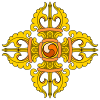
| ॐ Primordial Buddha (Vajradhara, Dorje Chang) > Historical Buddha (Gautama, Shakyamuni) (5th to 4th century BC) > Padmasambhava (Lotus Born, Guru Rinpoche) (8th century CE) > Tilopa (988-1069) > Naropa (1016-1100) > Marpa (The Translator) (1012-1097) > Milarepa (1052-1135) > Gampopa (1079–1153) > Rechungpa (1083/4-1161) > 1st Karmapa (Dusum Khyenpa) (1110-1193) > 2nd Karmapa (Karma Pakshi) (1204-1283) > 3rd Karmapa (Rangjung Dorje) (1284-1339) >> 16th Karmapa (Rangjung Rigpe Dorje) (1924-1981) > 17th Karmapa (Thaye Dorje) (Now) |
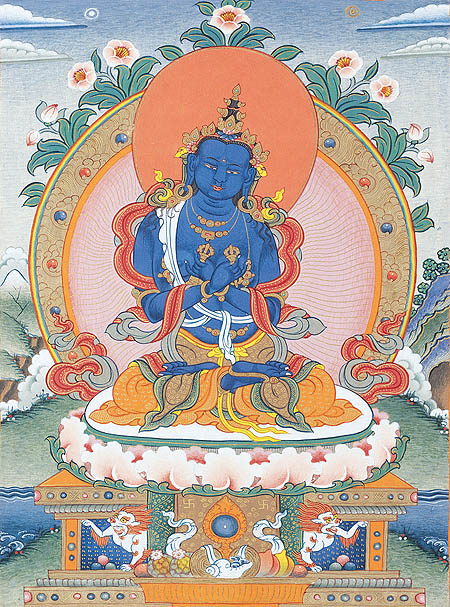
|
Vajradhara (Dorje Chang, Tib: rdo rje 'chang, Samantabhadra, Kuntuzangpo, "Ruler of the Vajra Beings") — celestial, primordial, Adi-Buddha, the Dharmakaya (Sanskrit: "truth/reality body", unmanifested, "inconceivable"), the quintessence of buddhahood itself, the ultimate.
Vajra means diamond (indestructible), as well as the thunderbolt, and the Dharmakaya/Vajradhara Buddha is the source of all the manifestations, and enlightenment.
Buddha Vajradhara is the supreme essence of all (male) Buddhas, and the prime Buddha of the Father Tantras, from whom were manifested the Five Wisdom Buddhas (Jinas, Tathagata Buddhas) of Mandala:
- Akshobhya "Immovable One" — represents "mirror-like", devoid of dualistic thought consciousness
- Amoghasiddhi "He Whose Accomplishment Is Not In Vain" — represents conceptual mind, volition
- Amitabha "The Buddha of Infinite Light and Life" — represents pure perception, deep awareness
- Ratnasambhava "Jewel-Born" — represents relationship of sensation with consciousness, feeling
- Vairocana "Origin Of All Buddhas" — represents voidness, source of all Buddha manifestations, form
|
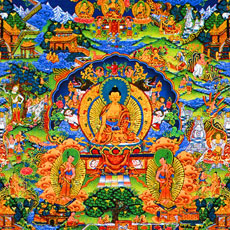 |
The Buddha (Prince Siddhartha, Gautama, Shakyamuni, "the sage of the Shakya clan") (5th to 4th century BC) — the historic Buddha, was a king who had everything but was not satisfied. He left his kingdom in search of enlightenment, wandered, struggled, tirelessly practised and attained full realization meditating under the bodhi tree in Bodhgaya, India over 2,500 years ago. After that, for about 45 years he taught Dharma (the teaching), to both monastic and lay disciples, and established the foundation of what we know today as Buddhism.
Among the Buddha's realizations was an insight into the true nature of reality — law of cause and effect, as well as dependent origination, reflective nature of consciousness, illusory nature of all phenomena, absence of a definitive Self/Brahman, and more. His teaching is based on his insight into suffering, cause of it — desire, and the end of suffering — Nirvana, as well as The Middle Way (life of inner and outer balance), or The Noble Eightfold Path, that leads to liberation.
In the East the Buddha is referred to as Perfectly self-awakened, the Conqueror (Jina, overcame all obstacles), the Subduer (restrained body, speech, and mind), the Exalted One, the Savior Of All Beings, Teacher (Lord) of men and gods, the Supreme King of Dharma, as well as the Tathagata — The Thus Come One, Gone Beyond or transcended, Bhagavato The Blessed One, or Bhagwan — guru, Lord, and Araham (Arahant/Arhat) the World-Honored One.
From the teachings of the Buddha and his immediate disciples, the oldest, most complete core of the standard Buddhist collection of scriptures called the Pali Canon (in Theravada, "School of the Elders") was preserved. |
|

|
Padmasambhava (an emanation of Buddha Shakyamuni, "Lotus Born", Guru Rinpoche, "Precious Guru") (8th century CE) — legendary Indian Buddhist mystic who brought Tantra to Tibet, and established the first Buddhist monastery there.
Legend says a boy was found sitting on a lotus, he said: "My father is the wisdom of spontaneous awareness. My mother is the space of all things. I sustain myself by consuming the concepts of duality. My purpose is the act of erasing disturbing emotions".
In the 8th century the emperor of Tibet established Buddhism as the state religion and invited famous Buddhist masters to Tibet, among them was the legendary Guru Rinpoche (Padmasambhava), who converted local shamans to Buddhism, tamed demons, and taught Dharma widely for many years. The Nyingma school, one of the four main schools of Tibetan Buddhism, mainly follows teachings from this time.
Padmasambhava is the buddha for the dark age, the one who works most powerfully with negativity of this eon — Kali Yuga.
Before leaving, Padmasambhava urged to accept Avalokiteshvara (Chenrezig) as the deity of Tibet (with the mantra Om Mani Padme Hum).
ॐ मणिपद्मे हूँ ཨོཾ་མ་ཎི་པ་དྨེ་ཧཱུྃ
In the end, he "mounted a beam of sunlight and in the flicker of a moment flew away into the sky... turned his face to look back and sent forth a light ray of immeasurable loving-kindness..."
|
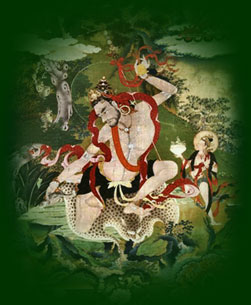 |
Tilopa (Talika, Tilopada) (988–1069) — known as Prajna Bhadra, Indian mahasiddha (Sanskrit: "great adept"), was born into the Brahmin caste; master of Mahamudra* ("Great Seal", wisdom and emptiness inseparable) and Tantra, which he unified and transmitted.
Early in life Tilopa entered monastic life and learned the Tripitaka (three collections of the teachings of the Buddha). Tilopa practised with a ksetra yogini, the daughter of a sesame seed pounder, and was expelled from the monastery. He then came to be known as "Tillipa", the sesame pounder (the tahini maker).
He lived along the Ganges River as a tantric practitioner and mahasiddha, practised Anuttarayoga Tantra** (esoteric tantric Indian Buddhism), and received various teachings from dakinis in the land of Oddiyana (Tib: Urgyen, historical Swat, Pakistan, transformed over time into a mythical pure land), until he realized the co-emergent wisdom (wisdom born from confusion, intensified emotions transmuted into brilliant sanity).
He became a holder of all the tantric lineages, possibly the only person in his day to do so. As well as the "Way Of Insight" (Vipassana, "insight", "clear-seeing", experiencing what is, strengthening mindfulness, cultivating compassion), and Mahamudra ("Great Seal"), he learned and passed on "The Way Of Methods" (path to liberation, today known as the "Six Yogas of Naropa"), and Guru Yoga (tantric devotional process where the practitioner unites their mindstream with the mindstream of the guru).
Tilopa received many teachings and transmissions from a variety of great Indian tantric masters, especially the “Four Special Transmission Lineages” (from four main teachers, Tib: “ka bab shi’i gyu pa”, abbr. “ka-gyu”), and for 12 years devoted himself totally to his practice before attaining full realization. From the ultimate point of view, Tilopa had no human teachers and received full Mahamudra and Vajrayana transmissions directly from Buddha Vajradhara.
Tilopa taught for many years, had many followers, became renowned as the Siddha Tillipa, and is one of the eighty-four mahasiddhas of India. His two most well known students were Lalitavajra, and Naropa the Golden Rosary lineage heir. |
 |
Naropa (1016-1100) — known as Abhayakirti (Tib: ‘jig med grags pa), was born into the Brahmin caste, a scholar of non-buddhist teachings, got inspired by a book on Buddhism and became an ordained monk. Naropa taught at the universities, became one of the most well-known abbots of the time, and was honored by being made the "Northern Gatekeeper" (faced toward China and Tibet) of Nalanda university.
When Naropa practiced Vajrayana tantric meditation of Chakrasamvara*** (mother class of the Anuttarayoga Tantra, "Discourse of Sri Heruka") he got challenged by a dakini to leave his academic life and look for a guru. Naropa had “entered the activity” (spyod pa la gshegs pa) of a wandering yogin. After finding Tilopa, Naropa served his guru for twelve years, and went through numerous hardships and tests, before becoming one of the greatest masters.
Naropa systematized the meditations he got from Tilopa into the famous Six Yogas of Naropa: Illusory Body, Phowa, Conscious Dreaming, Clear Light, Bardo, and Inner Heat. He held the Oral Instructions lineage and had many students including, Marpa, Atisha, Maitripa, and many other masters, among them eight extraordinary disciples, four learned in the Father Tantras, and four in Mother Tantras.
Naropa's principal student and heir Tibetan Marpa, the great translator, brought the lineage to Tibet. |
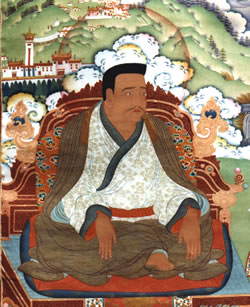 |
Marpa ("The Translator") (1012-1097) — Marpa Chokyi Lodro (Tib: mar pa chos kyi blo gros) was an enlightened master layman, a householder and a businessman. He is the first Tibetan master in this lineage, and the founder of the Kagyu school.
Marpa was born to a well-to-do family, began studying at a young age, and mastered the Sanskrit language. During his life Marpa travelled to Nepal and India three times, on foot over the Himalayas, to seek gurus and teachings. He converted his entire inheritance and collected gold all over Tibet to make offerings to his Indian gurus for the priceless teachings.
Marpa was recommended, and sought Naropa who would become his principal guru. He received a series of tantric initiations and instructions of Highest Yoga Tantra, with the Hevajra (one of the main yidams) and Guhyasamaja (Mahayoga Tantra, in Tibet "Unexcelled Yoga Tantra"), "Six Yogas Of Naropa" foremost among them. Marpa also studied with many teachers and trained under great adept Maitripa, from whom he received instructions on Mahamudra, and the tradition of doha songs of spiritual realization.
Marpa had thirteen gurus: Naropa, Maitripa, Santibhadra, Jnanagarbha, the "yogini adorned with bone ornaments," Kasoripa, Riripa, Jetaripa, Kukkuripa, Prajnaraksita, Chitherpa, Paindapa, and Atisa.
Upon his return to Tibet, Marpa spent many years translating important Buddhist scriptures, continued to practice and give teachings, abhishekas (empowerments), and transmissions to many students in Tibet. Some of his great students held Marpa’s tradition of the Teaching Lineage. After his third visit to India, famous yogi Milarepa became his disciple, and became Marpa's principal student and a lineage holder. |
 |
Milarepa (Mila, Jetsun Milarepa, rje btsun mi la ras pa) (1052-1135) — the most renowned and accomplished of Tibet’s tantric yogis, who against all odds achieved enlightenment in one lifetime. Milarepa held Marpa's lineage and tradition of the Practice Lineage.
Early Milarepa had a very difficult life, lost his father and inheritance, and was enslaved by his relatives. By request of his mother he turned to black magic to avenge his family's suffering, killed many people and caused great damage. After realising what he had done, and the bad karma he created, Milarepa searched for salvation.
At the age of thirty-eight Milarepa went to Lhodrak to find Marpa, and after building a nine-story tower eleven times (as his guru demanded to purify karma) was admitted to receive teachings. He spent over six years studying with great devotion, received the abhisheka of Chakrasamvara (Mother Tantra, "Discourse of Sri Heruka"), and a name Shepa Dorje ("Laughing Vajra"). Marpa gave Milarepa the full transmissions, instructions, and abhishekas of Tantra, as well as the lineage of Mahamudra – all that Marpa had received from Indian mahasiddhas Naropa and Maitripa.
At the age of forty-five, directed by his guru, Mila left to start life as a wandering yogin. He wore cotton robes repa (ras pa), and became known as Milarepa "Mila, the cotton clad one". Milarepa meditated in caves for twelve years, practiced Tantra, and attained the complete state of enlightenment. After that he taught Dharma to people, animals, demons, and god-like creatures; acquired superpowers, could fly, and perform "miracles". Milarepa promised help to everybody on the spiritual path, and saved countless beings. Most famous for his songs and poems, in which he expresses the profundity of his realization with extraordinary clarity, passion and beauty, Milarepa "The Snow Lion" is still beloved by many in Tibet.
Jetsun Milarepa had countless disciples, such as Rechung Dorje Drakpa (Rechungpa), the eight-heart-sons, and many others — among them, his spiritual successor who continued his lineage "the Physician from Gampo" master Gampopa. |
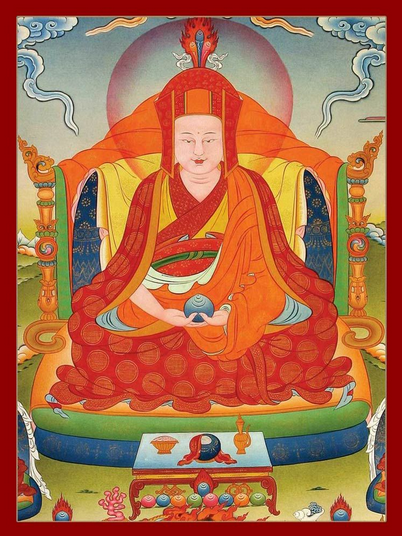 |
Gampopa (1079–1153) — Sönam Rinchen, Dharma Drak, Dhagpo Lhaje "Doctor from Dhagpo", "the Physician from Gampo", "the Incomparable Dharma Lord of Tibet", was Milarepa’s most renowned student prophesied in the sutras by Buddha. Gampopa was a doctor, and a tantric master that established the monastic foundation of the Kagyu lineage, and codified the teachings which form the foundation of the Kagyu educational tradition.
Since childhood Gampopa studied medical sciences, received training as a physician and became one of the best doctors of the time. Tragically, his wife and children died in an epidemic, after which he became a monk. Later, he began to dream of a "green" yogi. When they met, Milarepa's first instruction to Gampopa was to drink a cup of chang (Tibetan beer). Gampopa hesitated, as a monk he was forbidden to drink alcohol, but Milarepa admonished him: "Don't think so much. Just drink it." Gampopa drained the cup and was embraced as a son by Milarepa.
Gampopa practiced with great diligence and endured many hardships under his guru. As Milarepa's foremost disciple, Gampopa marked the transition from the independent yogis of early Tibetan Buddhism to the monastic tradition that exists to this day. He accomplished this by bringing the Kadampa (oral instruction) monastic system together with the Kagyu teachings, and pioneered in establishing the framework of the lineage by unifying Milarepa's Mahamudra with the stages of the path tradition of the Mahayana school (Kadampa) founded by the great Indian Buddhist Master Atisha.
Gampopa led his own students first through the common Mahayana path of the Kadampa lineage teachings, and then through the uncommon Mahamudra and Tantra path of the Kagyu lineage instructions of Milarepa.
Gampopa had three heart disciples: Phakmo Drupa, Saltong Shogom, and Düsum Khyenpa (the First Karmapa). |
 |
Rechungpa (1083/4-1161) — Rechung Dorje Drakpa, Dorje Drak "Vajra-Glory", "moon-like“ disciple, foremost heart son of Milarepa, and a patriarch of the Kagyu lineage. He met Milarepa at the age of eleven, and spent many years studying and practicing under the guidance of his master. Like Milarepa he was a repa (ras pa, cotton-clad yogi, ascetic)****, unlike Gampopa, who was a fully ordained monk.
At one time Rechungpa was married to a local princess, before taking to the homeless life of a wandering yogin again. He was prophesied by Naropa, who said to Marpa that a descendant of his lineage would eventually come to receive more instructions on certain teachings. Milarepa sent Rechungpa to India three times to obtain teachings and transmissions which Marpa had not managed to receive in his time.
Rechungpa was Milarepa's undisputed master student and lineage holder, and Milarepa passed on the entirety of his teachings to him, whereas other students received only introductions and general outlines of teachings which Rechungpa had received in full. After Milarepa's passing, Gampopa requested and received some transmissions from Rechungpa which he had not managed to get from Milarepa before.
1st Karmapa Düsum Khyenpa went into the presence of Rechungpa and requested transmissions from him.
Rechungpa was particularly important in the transmission of the insider teachings, called The Six Equal Tastes, and cycle of the Chakrasamvara Tantra known as the Demchok (Rechung) Nyengyu.
Just as we need the sun and the moon for the balance on Earth, we need both the paths of Rechungpa and Gampopa as symbols of who we are, who we might wish to become, and from which point we wish to engage with Dharma. It is also an honored tradition, and a method, which roots are tracing back to legendary Tilopa and Naropa.
Read More |
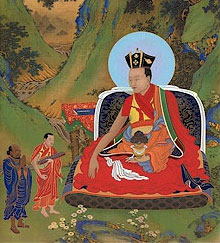 |
Karmapa — Buddha Shakyamuni predicted the coming of the Karmapas. Karmapa means “the one who carries out buddha-activity” or “the embodiment of the activities of the buddhas”.
Düsum Khyenpa (1110-1193), also known as Khampa Usey (literally, the “white-haired Khampa”), became known as the First Karmapa, who established the Karma Kagyu lineage.
The line of transmission after the 1st Karmapa is known as the Karma Kagyu, which the Karmapas have led ever since. There are also other branches of the Kagyu that have survived until today. The Karmapas head the Karma Kagyu lineage, and have incarnated in this form for 17 lifetimes.
Read More |
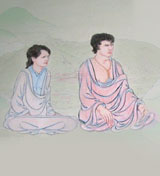 |
Lama Ole Nydahl (born 19 March 1941) — also known as Lama Ole, under the spiritual direction of The 16th Gyalwa Karmapa, together with his wife Hannah Nydahl founded Diamond Way Buddhism, a Buddhist organization for lay practitioners within the Karma Kagyu school of Tibetan Buddhism.
https://lama-ole-nydahl.org/teaching-schedule/ |

Avalokiteshvara (Padmapani, Chenrezig, Kannon, "All-Merciful One") — a bodhisattva, embodies the compassion of all Buddhas, is the earthly manifestation of the self-born eternal Buddha Amitabha, whose figure is represented in his headdress, and one of his two main disciples (along with Vajrapani). Avalokiteshvara guards the world in the interval between the departure of the historical Buddha, Gautama, and the appearance of the future buddha, Maitreya.
Chenrezig Sadhana (pdf)
Maitreya (Ajita) — is a bodhisattva of the future, a time when the Dharma will have been forgotten by most in the world. According to scriptures, Maitreya is a successor to the Gautama Buddha, and is a keeper of continuity of the teaching.
Vajrapani — one of two main disciples (along with Avalokitesvara) of the celestial Buddha Amitabha. A bodhisattva, one of the three protective deities surrounding the Gautama Buddha. Each of them symbolizes one of the Buddha's virtues:
— Avalokitesvara manifests all the Buddhas' compassion;
— Manjushri manifests all the Buddhas' wisdom;
— Vajrapani protects Buddha and manifests all the Buddhas' power.
Amitabha (Amitayus, Amida) — is a celestial buddha, one of the Five Mandala Buddhas, he is the principal buddha in Pure Land Buddhism. His two main disciples are the bodhisattvas Vajrapani and Avalokiteshvara, the former to his left and the latter to his right. The Panchen Lamas and Shamarpas are considered to be emanations of Amitabha. He is frequently invoked in Tibet either as Amitabha – especially in the phowa practices or as Amitayus – especially in practices relating to longevity, and preventing an untimely death.
Amitabha is the center of a number of mantras in Vajrayana practices
The Sanskrit form of the mantra of Amitābha is: ॐ अमिताभ ह्रीः (om amitābha hrīh)
Tibetan version: Om ami dewa hri (Sanskrit: om amideva hrīh)
Amitabha's most important enlightenment technique is the visualization of the surrounding world as a paradise by corresponding positive thought (and wishing all beings to be happy).

*
Mahamudra literally means "great seal" or "great imprint" and refers to the fact that "all phenomena inevitably are stamped by the fact of wisdom and emptiness inseparable".
**
Anuttarayoga Tantra (Sanskrit, Tibetan: bla na med pa'i rgyud, Unexcelled Yoga Tantra, Highest Yoga Tantra) — esoteric tantric Indian Buddhist texts (set of spiritual practices intended to accelerate the process of attaining Buddhahood) that constitute part of the Kangyur, or the 'translated words of the Buddha' in the Tibetan Buddhist canon.
In the New Schools of Tibetan Buddhism, Anuttarayoga Tantra is the highest of four classes and is associated with the Mahamudra route to enlightenment. According to the Kagyu tradition, in Highest Yoga Tantra, the Buddha taught the most profound instructions for transforming sensual pleasure into the quick path to enlightenment, which in turn depends upon the ability to gather and dissolve the inner winds (Sanskrit: prana) into the central channel through the power of meditation.
In the classification of the Dzogchen system, it is considered equivalent to the Mahayoga tantras of Nyingma (oldest school). The Dalai Lama XIV states: "old translation Dzogchen and new translation Anuttarayoga Tantra offer equivalent paths that can bring the practitioner to the same resultant state of Buddhahood".
The practice of Anuttarayoga Tantra in the Vajrayana tradition of Buddhism is characterized by the requirement of empowerment from a qualified guru (lama), use of ritual techniques, and the practice of various meditative and subtle body yogas, to effect personal transformation and to attain enlightenment through the realization of the mindstream (Sanskrit: citta-santana) as a meditational deity, or a yidam. It's admitted that Anuttarayoga Tantra texts "have remained at the forefront of contemplation, ritual, and interpretation throughout the Himalayan Buddhist sphere".
***
Chakrasamvara Tantra (Tib: 'khor lo bde mchog) is considered to be of the mother class of the Anuttarayoga Tantra in Vajrayana Buddhism. It is also called the Discourse of Sri Heruka (sriherukabhidhana) and the Samvara Light (laghusamvara).
The Chakrasamvara Tantra is mostly dedicated to describing rituals and meditations which produce either mundane siddhis (accomplishment) such as clairvoyance, flight, and the supramundane siddhi of awakening. These are achieved through deity yoga/yidam (visualizing oneself as the deity) and the use of mantras.
****
Repa (ras pa, cotton-clad, wandering yogi, ascetic) tradition was started by Marpa and Milarepa, as they were both laymen. Originally repas practiced Karmamudra, were hermits, and spent much of their time meditating in retreat. There was also tradition in the female repas, such as Kunden Rema and Machig Onjo from Rechung Kagyu lineage. Apart from Rechung Kagyu, Barom Kagyu is a lineage that is famous for upholding repa tradition, and there were some exceptional repas in all Kagyu lineages. Nowadays many repas in Tibet are ordained monks who trained in tummo and granted a white robe, and Kamtsang Kagyu (Karma Kagyu) apparently did some effort to revive it recently.
+
Both the Hevajra (one of the main yidams in Vajrayana), and the Kalachakra Tantras are commentaries on, or introductions to, the Guhyasamāja Tantra of the Secret Community (as suggested in Blue Annals).

The four schools: Nyingma, Sakya, Kagyu, and Gelug, are the main schools of Tibetan Buddhism. They preserved the Hinayana, Mahayana, and the Vajrayana level of Buddha’s teachings for centuries.











